
With a couple of meanders through my morning blogroll, I found a great community web site in my hometown, Syracuse. It's for the neighborhood of Eastwood (which I was completely ignorant of while growing up there, so enthralled I was asa teenager with trips to the newly opened shopping mall), and the lady who runs Walkable Eastwood, Lonnie Chu, asks good questions and creates a good community feeling on the site. It's made with simple HTML and basic clipart, which in this day of Flash and action script overload, makes the site seem almost more modern.
Look on the left-side bar for her description about porches and other neighborhood observations. Very PPS!
6.30.2006
Living it up in Eastwood
Posted by Shin-pei at 10:28 AM 1 comments
6.28.2006
Green by Design - Tonight!

Chicago City Hall Green Roof, image from ASLA. I looked for images of green roofs in NYC, but Chicago kicks our butt!
I'm sad I'm going to miss this panel discussion on green design, but if anyone's in UWS tonight, swing by the 92nd St Y at 7PM.
"Green by Design," the next event in Bryan Keefer's series of discussions on next-wave culture at Makor, the Upper West Side branch of the 92nd Street Y for New Yorkers in their 20s and 30s, takes place on Wednesday, June 28th, at 7:00pm.I've started Pulse myself, and you can read it too, in installations.
Featured panelists include Dominic Muren, an engineer, toy designer and contributor to Treehugger.com; Yael Alkalay, founder and CEO of red flower, a line of beauty products made with organic and sustainable botanicals; and Robert Frenay, author of Pulse: The Coming Age of Systems and Machines Inspired by Living Things.
Posted by Shin-pei at 10:27 AM 0 comments
6.27.2006
Places to be: NYC + Chicago

Tonight, June 27 is the world premier of Contested Streets, a production of Transportation Alternatives/Cicala Filmworks. The film:
explores the rich diversity of New York City street life before the introduction of automobiles and shows how New York can follow the example of other modern cities that have reclaimed their streets as vibrant public spaces.IFC Center, there's no time posted anywhere I looked, but I think it starts at 6PM.
Tomorrow night, Wednesday, June 28 in Washington Square Park, there will be a celebration of Jane Jacobs. The celebration will take place near the big arch. Activities begin at 5PM.
And for those reading in Chicago, I really liked the sound of this seminar, "Housing + Transportation: Moving the Region toward Greater Affordability," sponsored by the Center for Neighborhood Technology and the Chicago Rehab Network. More info at CNT. Mostly I liked it because the description combined housing and transportation issues, threw in the potential of finding a solution through technology, and mentioned unveiling hidden costs.
Posted by Shin-pei at 4:14 PM 0 comments
6.23.2006
96th and Broadway sidewalk proposal

A beautiful debate happening on Starts and Fits about the DOTs plans to move the sidewalk at 96th street. Check it out. (And I side with S&F...if the city is going to bother with some construction to make these changes, there's no reason not to aim higher and really get some neighborhood benefit, rather than car benefit with the construction.)
Posted by Shin-pei at 4:09 PM 0 comments
Graphing social capital

Relative Measure of Social Capital by US States
I received Bowling Alone, Robert Putnam's introduction and analysis on the importance of social capital, for Christmas, but couldn't slog through it as much as I wanted to. I'm a wimp. The Oil Drum sums it up pretty nicely, with graphs and all. I know I'm not the only one that didn't finish the book, so thank you for doing that. (via Urban Cartography)
Update: Nikka from CitySkip spotted this Times article, June 25 by Robert Putnam, about a new study about increased social isolation in the United States. Thanks!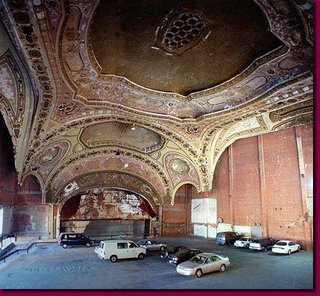
Fabulous Ruins of Detroit, from CitySkips' Detroit set
Posted by Shin-pei at 3:44 PM 4 comments
From Jonathan to Frank
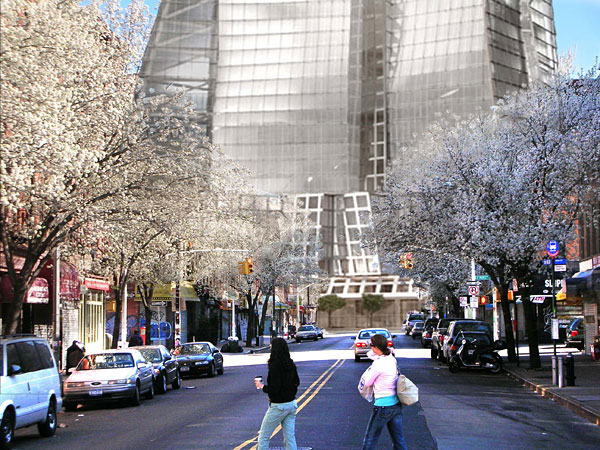
A projected view of the tower's in Gehry's proposal (image from Slate)
From one citizen to another - I like the style of communicating this way, the removal of defined roles. Here's Jonathan Lethem's letter to Frank Gehry about the Brooklyn Nets Arena proposal, a delicious piece of writing.
Posted by Shin-pei at 10:35 AM 0 comments
Catching up on food for thought
As usual, when you go away for a while, there's a feeling that there's a lot to catch up on. I paged through Metropolis for a while early this morning, read the Paul Goldberger commentary on Jane Jacob's legacy, the very interesting observation on how modernist, iconic architecture did not result in a sustainable transformation of Columbus, Indiana, (via subscription only, darn, worth trying to track down), then came in this morning and saw the critique of Shake Shack.
BTW, I don't agree that the Shake Shack is so egregious - after all, Madison Square Park is just as deserving of vibrancy in its somewhat tony and yuppie location, but I thought the points made about how it could have been better were well said. The main thing here is that Madison Square Park Conservancy should not rest on its laurels with the success of Shake Shack, but continue to build on its success to add more activities to the park so that there is better triangulation. Right now, the park continues to feel a bit spotty in terms of uses and what's memorable are its uses by corporations for marketing gambits, i.e. the recent event with Fabio and I can't believe it's not butter.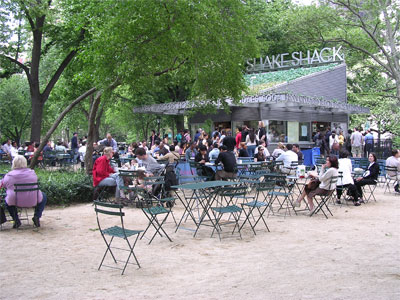
Shake Shack: a vibrant place and destination, but not much to do once you leave the movable seating area
Posted by Shin-pei at 10:13 AM 0 comments
Very orange

Hup Holland!
When I originally wrote Orange for a week, I didn't realize just how orange our trip would become. All the photos on the camera we brought have the Holland mascot lion in them.
The best part of the trip, moving from the geography from city to country, is that there seemed to be a consistent application of land-use/space principles throughout. Even the private homes we stayed in used all available space, and yet everything felt open, light and functional. I loved it.
Posted by Shin-pei at 10:07 AM 0 comments
6.13.2006
Orange for a week

Image from pher
We're heading over to the Netherlands today, hanging out in Amsterdam, hopefully catching the Netherlands/Ivory Coast game in the city, then going to a wedding party in Breda.
For a couple of days, we'll be living in a houseboat. Be back next week!
Posted by Shin-pei at 12:16 PM 0 comments
6.12.2006
Want to host a yellow chair?
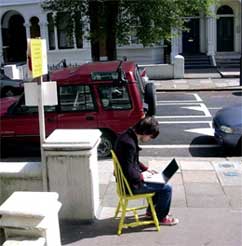
"How domestic wireless networks can be built upon to create lively community space."
Putting out a yellow chair, advertising a web site that anyone can access from the chair, posting offers for exchange or barter. The designers/artists, Anab Jain and Tom Jenkins, are looking for households for the next round. via we make money not art
Posted by Shin-pei at 1:05 PM 0 comments
Umm...yes

"Is New York Magazine doing PR for Developers?"
Absolutely, positively, yes! Actually, I think most of our New York-based media has pumped up editorial outlook to be more in line with garnering pricey ads from developers, no? Case in point: NYTimes Sunday Real Estate section, which gets more watered down by the week (though it grows thick from increasing ad sales) and the recently minted "Special Edition: Real Estate" for the NYTimes Magazine. There's little to no critique on behalf of the greater good of the city.
Posted by Shin-pei at 12:38 PM 0 comments
World Cup a part of our everyday
I have a couple favorite morning coffee stops on my way to work. One of them is an industrious guy in a coffee cart on Lafayette right off of Bleecker Street. He has some of the lowest prices around (though today he raised them about 15 cents, which I agreed with - I always felt that he could raise his volume by charging cent-rounded prices, i.e., $1.25, instead of counting out change for $1.65 or $1.85.)
Anyway, today the line was plein-full of World Cup talk. This is the kind of morning chatter that makes getting coffee in a highly public area so fun. That's also the beauty of the World Cup - from Germany, to a little coffee cart in downtown Manhattan.
Posted by Shin-pei at 12:32 PM 1 comments
Hurray for redwoods in the city!

The large redwood tree in the Liz Christy Community Gardens, reputedly planted by the mother of the NYC community gardens movement herself, has survived the Avalon Bay development.
We live near the garden, which makes Houston Street hospitable for one treasured block - thank you Liz Christy gardeners. Seems like only yesterday that the ground was broken, and I'm glad that the damage wasn't worse.
Posted by Shin-pei at 12:24 PM 0 comments
6.08.2006
Q&A: Creative use of overpass
Paul from Boston writes: I currently live in Boston. There is an overpass near Kenmore Square that has always bothered me. I think the fact that the city has attempted to pretty it up with better lighting, trees, and benches has made me notice how awful it is even more than if it was just left alone. It got me thinking about how to make good use of the dead space. I have read some articles about parks under overpasses in Seattle and an entire marketplace underneath a defunct viaduct in Paris. I was wondering if you had any thoughts on the subject or if you knew of any articles etc. that explore the possibilities.
I lived for about 4 years in Boston, and I think this is the overpass you're talking about (Bowker or Charlesgate Overpass off of Storrow Drive).
Cars only on the overpass!
Regardless, overpasses are becoming a bigger problem as people find that they are impossible to expand when they cut through a city, and that they suck away so much energy from the city by their presence. Here's a little history of this micro-area before the overpass was built.
Seattle's Freeway Park
The places you're talking about in Seattle and Paris may be different types of infrastructure. Project for Public Spaces worked on Freeway Park, which is the landscape architecture designed park under the freeway that cuts through downtown. Here's PPS's description of the park and with recommendations,
the Seattle Parks and Recreation description, and Lawrence Halprin's Cultural Landscape Foundation on Freeway Park, with some critique of PPS's work. Finally, more photos. 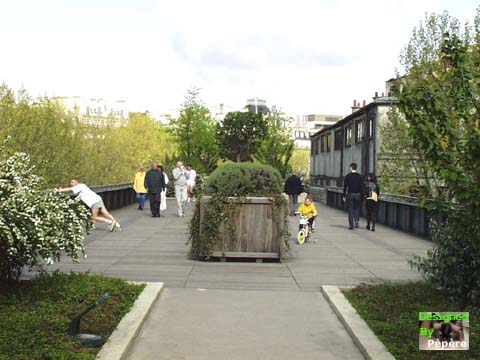
Paris's Promenade Plantee, a BTTN personal favorite
The park you refer to in Paris is the Promenade Plantee, a park built on an old viaduct and abandoned railtracks. Here's the PPS description of it, the park's own web site, and the Boston Globe's own comparison between the Promenade Plantee to the park above the Big Dig.
Posted by Shin-pei at 3:50 PM 1 comments
6.06.2006
Light, light

Postings are light of late. Over Memorial Day weekend, a de-cluttering attack hit us and over the three days we expunged our apartment, left a few residual pieces out on the curb and delighted in the gradual disappearance of our castaways. We know that they found a better home and are now more appreciated. Here's a better collection of that ephemera.
I'm also doing a lot of research on the intersection of place, corporate responsibility and civic good. Inserting "place" into this adds an interesting dimension, and seems to reveal a gap. Anyone got anything good to send over, please do.
Posted by Shin-pei at 4:53 PM 1 comments
6.01.2006
Choreography of public spaces

Great article about people's movements through public spaces, and how design facilitates or obstructs it (lost in the Arts section of the New York Times).
The one correction in the article I think worth pointing out is that the example of Channel Gardens at Rockefeller Center, with the tall buildings on either side, were not always an asset - they were once a liability for the space. The configuration is a typical one in many smaller cities, with a small downtown filled with large office buildings. People put in a public space with good intent, but success requires more than physical space set aside. In the mid-1970s, there were "undesirables" inhabiting the Channel Gardens and the small retail storefronts in the channel to fail. PPS was commissioned to figure out what types of spikes to put in around the plantings to protect the vegetation. Instead of spikes, PPS advised putting in benches and created a destination at the end of the garden. This is perhaps too simplistic but the benches compelled people to sit, maybe eat lunch, and people walking down Fifth Avenue saw people eating lunch, looked down the Channel Gardens and saw something else at the end, and then would feel the gravitational pull that the article describes.
These elements probably had more to do with the magnetism of the site than the massing on either side of the Channel Gardens, though today, with all these elements, the massing helps instead of hinders.
Posted by Shin-pei at 9:59 AM 0 comments